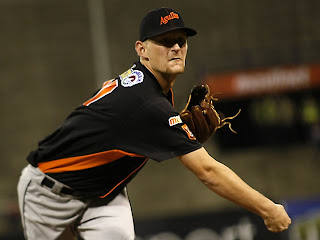There are always a number of fascinating articles in each issue of The Baseball Research Journal, but the recent Fall 2011 publication had one that particularly caught my eye. Jim Albert authored "
A Graphical View of the SABR Era", an interesting look at changes in various statistical measures in baseball from 1971 to the present day. The year of 1971 was chosen since that was when the Society for American Baseball Research was founded, but that year happens to be just two years before the American League introduced the Designated Hitter. Although a variety of conclusions can be drawn from the paper, the statistical trends outlined provide an interesting view into the impact and effectiveness of the DH.

My first observation is that the DH is responsible for quite a bit less additional offense that one would expect. I have always been under the impression that the DH produces about 0.5 additional runs per game, but as Figure 1 shows, the difference in runs between the two leagues in the last 40 years has never been more than 0.4 runs per game. However, that difference has been declining steadily since the late 1990's and it currently sits at a measly 0.2 runs per game.
Many proponents of the DH like to mock the "regular" sight of a National League pitcher feebly striking out. If that was indeed the case then one would expect almost two extra strikeouts per game. However, as Figure 5 shows, the biggest difference between the two leagues since 1971 is only about 0.6 strikeouts per game and some years it has been as low as 0.3 per game. That's not exactly a boredom-inducing occurrence.

On the other side of the coin, I would have expected steals in the NL to be well above the level of steals in the AL. That actually was true -- throughout the 1980's. Back then, the National League was in love with small ball and the AL was mainly following Earl Weaver's strategy of playing for three-run homers. But an interesting twist has developed in the last decade: the AL has stolen more bases than the NL and the gap has been quickly increasing over the last five years. So much for my old argument that the DH is responsible for a sizable drop in stolen bases!
The final graph of interest is the most important one: attendance. The DH was brought in by the American League to help with flagging attendance. Back in 1971, the National League was averaging about 3,000 more fans per game than the junior circuit. That figure in 2011? Still 2,800 extra fans per game for the NL. From an attendance perspective, the DH has not exactly been a resounding success.
There are many downsides to the DH (reduced strategy due to fewer bunts and pinch hitting, lessened importance of managing, not being able to experience the thrill or heartbreak of a key hit by a pitcher, etc). Given the limited benefits of the DH, one has to wonder how much longer it will be around. My guess is that it will take a new commissioner before this failed 1970's experiment is finally killed off. Sadly, Bud Selig just missed a golden opportunity by not eliminating the DH in the recently agreed-upon collective bargaining agreement. In 2013, the Houston Astros will join the American League and the two leagues will each feature 15 teams. That means that there will be at least one inter-league game all season long. It's a real shame that they'll continue to play with two sets of rules.
 Austin Bibens-Dirkx, a dominant pitcher for the Victoria Seals in 2009, has been tearing it up in the Venezuela Winter League. He was recently named as a VWL All Star, based on his outstanding 2.47 ERA (6th best in the league) and 1.05 WHIP. He has also posted a 5-2 record in 11 appearances for Águilas del Zulia. The All Star game is scheduled for this Tuesday night.
Austin Bibens-Dirkx, a dominant pitcher for the Victoria Seals in 2009, has been tearing it up in the Venezuela Winter League. He was recently named as a VWL All Star, based on his outstanding 2.47 ERA (6th best in the league) and 1.05 WHIP. He has also posted a 5-2 record in 11 appearances for Águilas del Zulia. The All Star game is scheduled for this Tuesday night.












